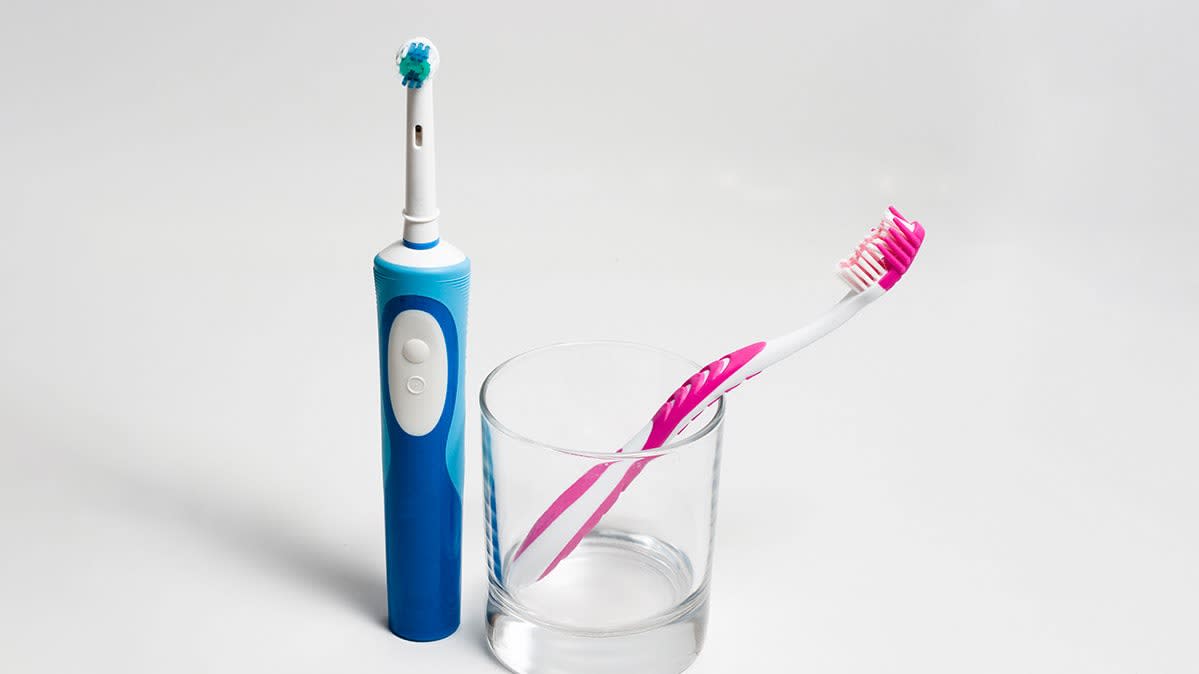Toothbrush Tips for Older Adults

G ood dental habits are always important, but with age, at-home oral hygiene becomes more crucial. Older adults in particular can be susceptible to many oral problems, such as gum recession, tooth sensitivity, and cavities.
One factor? Common meds can cause dry mouth. “Saliva is nature’s cavity fighter because it washes bacteria and plaque away from your teeth,” says Alice Boghosian, D.D.S., a spokesperson for the American Dental Association (ADA) and a clinical instructor at the University of Illinois at Chicago College of Dentistry. “Without it, plaque sticks to teeth, increasing your risk of cavities.”
Your best defense is to brush thoroughly two times a day. Here, how to get the job done well.
What to Know When Choosing a Brush
You can buy a manual toothbrush for less than $1, and powered brushes range from basic models for less than $20 to high-end devices that cost more than $250.
For either type of toothbrush, opt for one with soft bristles, advises Vera W. L. Tang, D.D.S., clinical assistant professor, vice chair, and predoctoral director at the New York University College of Dentistry. “It doesn’t take much force to brush away enamel [and gum tissue], which leads to tooth decay and gum recession,” she says. Some research has found that brush heads with tapered or rippled bristles clean more gently and effectively.
Some research does suggest that powered brushes may be slightly more effective at cleaning away plaque and keeping gums healthy. But “people who do a good job can do a good job with any type of toothbrush,” says Paulo Camargo, D.D.S., chair of periodontics at the UCLA School of Dentistry.
Many powered brushes have larger handles, making them easier to grip. And because you may become less dextrous with age, you’ll want a brush that’s comfortable to hold on to, says Tang.
But “some have very strong vibrations,” she adds. For people with arthritis or problems with their grip, the strong vibrations may cause them to drop the toothbrush too easily.
(If you have trouble gripping a toothbrush, whether manual or powered, you can wrap the handle in a dish towel and secure it with rubber bands, or slip a bicycle handlebar grip or other foam tube over it.) For both types, when bristles start to fray or splay, after about 3 months, replace the brush or brush head.
Other considerations: While experts say you can brush well with an inexpensive brush, some features on powered brushes may be helpful. For instance, a built-in timer may encourage those who hurry through cleaning their teeth to brush for the recommended 2 minutes. And some models even buzz every 30 seconds to remind you to move to another section of your mouth.
A brush with a pressure sensor that alerts you when you’re brushing too hard may help reduce tooth sensitivity or keep it from worsening. “The nerves of the teeth tend to recede with age, so you don’t get the warning signs of sensitivity when you press too hard,” says Tang.
Know the Proper Technique
According to the ADA, most people brush their teeth for an average of only 45 seconds, but 2 minutes is recommended. To ensure a thorough cleaning, Boghosian suggests dividing your mouth into four areas and spending 30 seconds on each zone.
Hold your brush at a 45-degree angle so that bristles point to where your teeth and gums meet. With a manual brush, gently move it in small circles and use short strokes (sweep down for upper teeth and up for lower teeth).
With powered brushes, the vibration or rotation does most of the work. “Just set the brush on two teeth at a time,” Tang says, “and let it do its thing.”
Clean the front, back, and top of your teeth, as well as between them, and under bridges. “Gums recede with age, so there’s more room for food to get trapped between teeth,” Boghosian says. Interdental brushes, floss picks, or floss holders may help you navigate more easily.
Editor’s Note: This article also appeared in the May 2020 issue of Consumer Reports On Health.
Consumer Reports has no financial relationship with advertisers on this site.
More from Consumer Reports:
Top pick tires for 2016
Best used cars for $25,000 and less
7 best mattresses for couples
Consumer Reports is an independent, nonprofit organization that works side by side with consumers to create a fairer, safer, and healthier world. CR does not endorse products or services, and does not accept advertising. Copyright © 2020, Consumer Reports, Inc.

